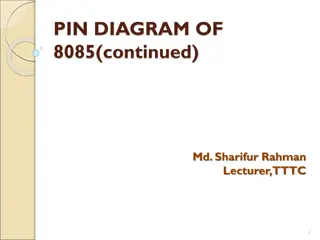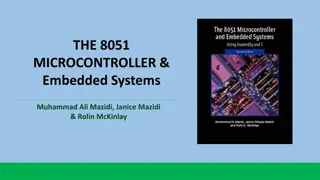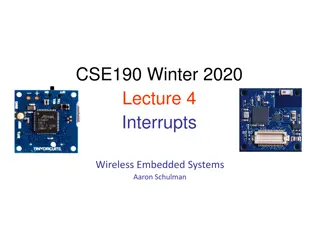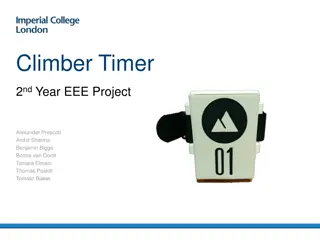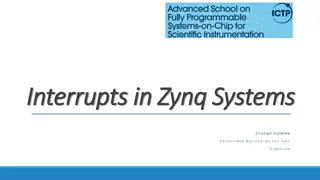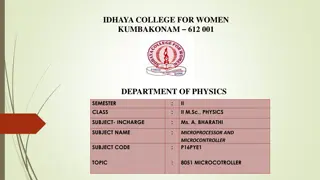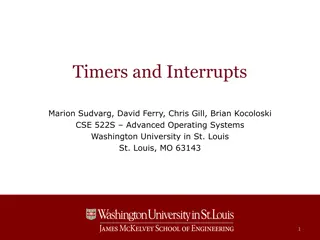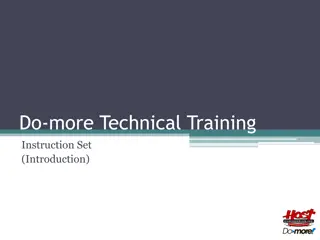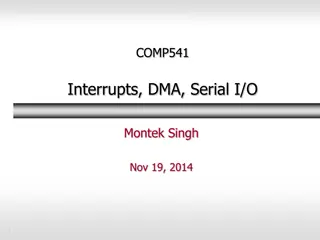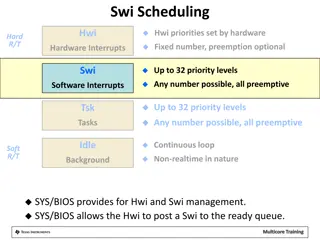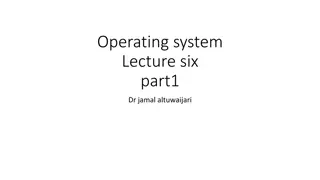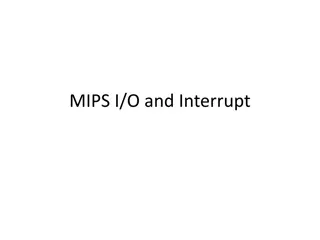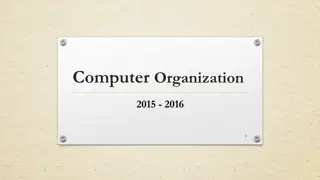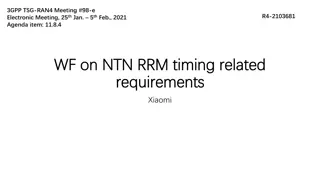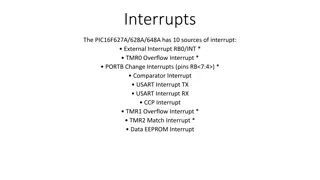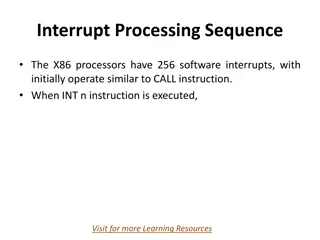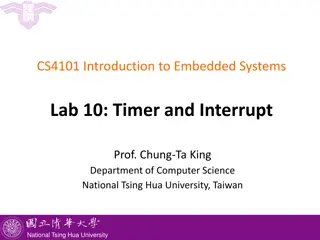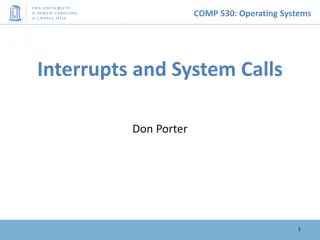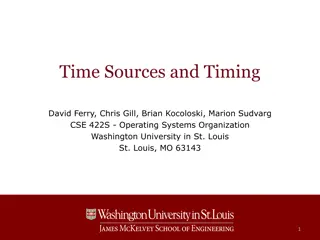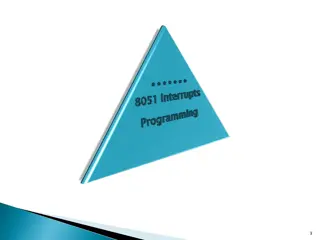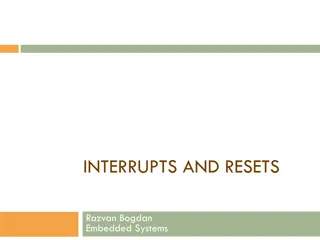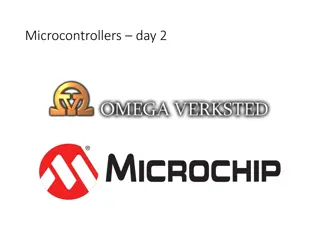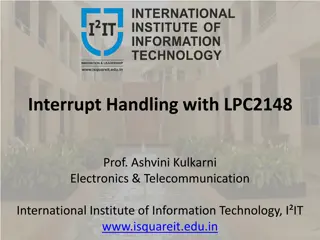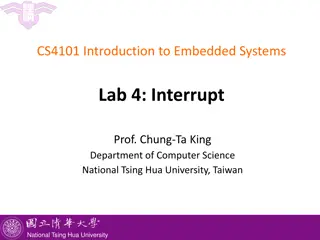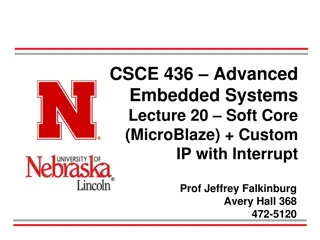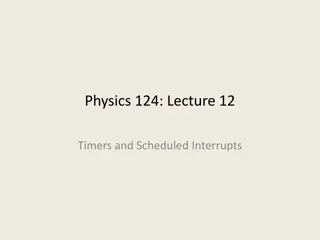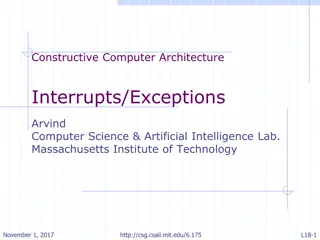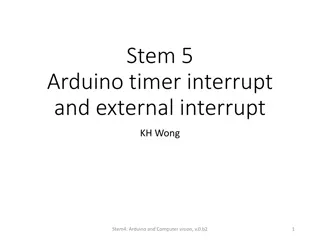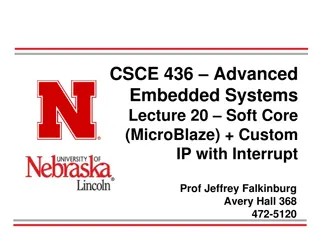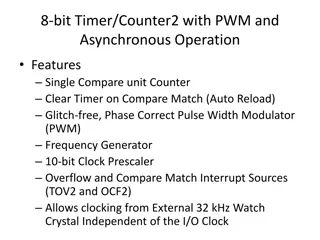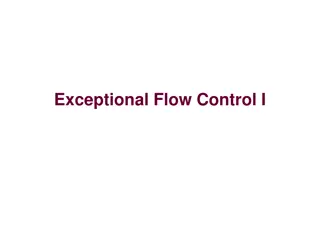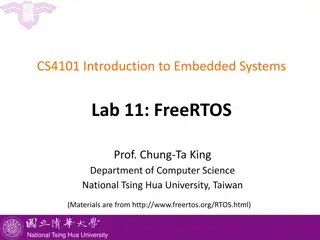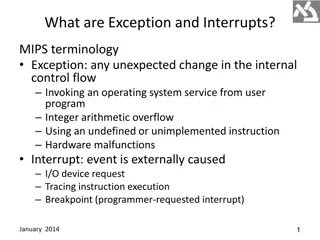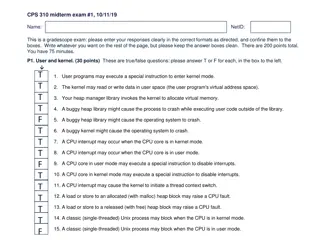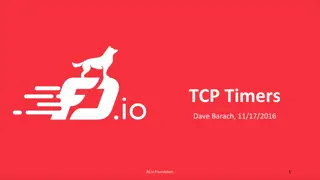Comprehensive Guide to 8085 Microprocessor Interrupts and Pin Diagram
Explore the PIN diagram of the 8085 microprocessor, understand interrupts, including hardware interrupts like TRAP, RST, INTR, and the classification of interrupts such as maskable, non-maskable, vectored, and more. Learn about the sequence of steps during interrupts and their significance in microp
12 views • 31 slides
Introduction to 8051 Microcontroller Timer Programming
Explore the world of 8051 microcontroller timer programming through this comprehensive guide. Learn about the timers, their registers, modes, and how to program them in Assembly and C language to generate time delays and event counters. Delve into examples to understand timer selection, clock freque
1 views • 46 slides
Understanding Interrupts in Embedded Systems
In embedded systems, interrupts play a crucial role in letting peripherals notify the CPU of state changes. They are events external to the current process that disrupt the normal flow of instruction execution, typically generated by hardware devices. By using interrupts, CPUs can efficiently handle
1 views • 12 slides
Climber Timer: Innovative Climbing Center Solution by EEE Project Team
Climber Timer is an innovative solution developed by a team of EEE project members to help climbers easily time and log their climbs at climbing centers. The device is designed to retrofit onto existing walls and offers features like ascent time recording, auditory feedback, and data upload capabili
0 views • 24 slides
Techniques for Reducing Connected-Standby Energy Consumption in Mobile Devices
Mobile devices spend a significant amount of time in connected-standby mode, leading to energy inefficiency in the Deepest-Runtime-Idle-Power State (DRIPS). This study introduces Optimized DRIPS (ODRIPS) to address this issue by offloading wake-up timer events, powering off IO signals, and transferr
1 views • 31 slides
Understanding Processor Interrupts and Exception Handling in Zynq Systems
Learn about interrupts, exceptions, and their handling in Zynq Systems. Explore concepts like interrupt sources, Cortex-A9 processor interrupts, interrupt terminology, and the difference between pooling and hardware interrupts. Gain insights into interrupt service routines, interrupt pins, interrupt
0 views • 60 slides
Understanding the 8051 Microcontroller: Features, Registers, and Applications
A detailed overview of the 8051 microcontroller including its introduction, features, and registers. Explore how the 8051 is useful for small computing tasks, control applications, and its low power consumption. Learn about the various registers in the 8051 such as the accumulator, program counter,
0 views • 18 slides
Understanding Timers and Interrupts in Operating Systems
This content discusses the importance of timers and interrupts in operating systems, focusing on how they facilitate preemptive multitasking. It covers how hardware timer interrupts help in preemption of processes by the kernel, ensuring efficient task scheduling and resource management in modern op
4 views • 18 slides
Comprehensive Introduction to Technical Training Instruction Set
Delve into the basics of technical training instruction sets covering 181 different instructions. Explore key concepts such as coil/bit output, analog/process control, program looping, timer/counter functions, and more. Understand the operational characteristics of different instruction categories,
0 views • 19 slides
Understanding Interrupts in Computer Systems
Interrupts in computer systems play a crucial role in handling various events and managing the flow of instructions. This content discusses the types of interrupts, causes, handling procedures, and the role of supervisory modes in modern computers. It covers topics such as internal and external inte
0 views • 29 slides
Real-Time Interrupt Handling and Scheduling in SYS/BIOS
This content covers the management of hardware and software interrupts, interrupt priorities, scheduling rules, and execution flow for real-time systems using SYS/BIOS. It discusses the handling of interrupts by the Hardware Interrupt (Hwi) and Software Interrupt (Swi) components, priority levels, p
0 views • 4 slides
Understanding Interrupt Processing in Operating Systems
An interrupt in an operating system disrupts the normal sequence of instructions executed by the processor. When an interrupt occurs, the OS takes control, saves the state of the interrupted process, analyzes the interrupt, and passes control to the appropriate routine. There are six classes of inte
0 views • 15 slides
Understanding MIPS I/O and Interrupt Handling
Delve into the world of MIPS architecture, exploring how I/O operations and interrupts are managed. Learn about memory organization, system functions, I/O registers, and kernel data. Discover how SPIM facilitates input and output handling, including reading from the keyboard and managing output. Div
0 views • 18 slides
Understanding Computer Organization: Instruction Set Architecture and Interrupts
Explore the critical concepts of Computer Organization focusing on Instruction Set Architecture (ISA) and Interrupts. ISA serves as the interface between hardware and software, enabling programmers to write machine language programs effectively. Learn about Application Binary Interface (ABI), interr
0 views • 26 slides
NTN RRM Timing Related Requirements for Xiaomi Devices at 3GPP TSG-RAN4 Meeting #98-e
The agenda item for the 3GPP TSG-RAN4 Meeting #98-e involves discussing NTN RRM timing related requirements, specifically focusing on UE timing synchronization for Xiaomi devices. Key aspects include UE transmit timing error limits, timing advance accuracy, and UE timer accuracy requirements for NTN
0 views • 6 slides
Understanding Interrupts in PIC16F Microcontrollers
Explore the key sources of interrupts in PIC16F627A/628A/648A, accessing registers, enabling interrupts, and managing local interrupts such as Timer 0 alarms and B0 pin changes. Learn how to set interrupts on desired events and understand the corresponding flag bits for interrupt occurrence.
0 views • 17 slides
Understanding Interrupts and Timers in Microcontrollers
Microprocessors function as finite state machines, with instructions loaded from memory and executed in sequence. However, interrupts allow for urgent out-of-turn servicing of signals, providing a way to handle asynchronous events. Learn how to utilize interrupts efficiently with examples on Arduino
0 views • 9 slides
Understanding Interrupt Processing Sequence in X86 Processors
X86 processors have 256 software interrupts, functioning similarly to a CALL instruction. When an INT n instruction is executed, the processor follows a sequence involving pushing the flag register, clearing flags, finding the correct ISR address, and transferring CPU control. Special interrupts lik
0 views • 10 slides
Embedded Systems Lab 10: Timer and Interrupt
This lab focuses on learning about timers and interrupts in embedded systems using MQX at National Tsing Hua University. It covers creating timer components, starting timers, and provides examples on simulating the control of an LED using timers. The content includes code snippets and explanations r
0 views • 15 slides
Understanding Operating System Interrupts and System Calls
Explore the fundamentals of operating system interrupts and system calls in COMP.530. Learn about synchronous and asynchronous interrupts, control flow handling, and the hardware tools available for irregular control flow. Delve into the key building blocks of operating systems such as context switc
0 views • 30 slides
Understanding Time Management in Operating Systems
Explore the concept of time in computer systems, including absolute and relative time, how the kernel tracks time, real-time clocks, system timers, and timer interrupts. Discover how time is a critical resource utilized by operating systems to provide essential functions for users.
0 views • 25 slides
Understanding Interrupts in 8051 Microcontroller
Interrupts in 8051 microcontrollers allow the system to respond to asynchronous events while multitasking on a single CPU, giving the illusion of handling many things simultaneously. They introduce the concept of priority, enabling preference over simultaneous interrupts. The interrupt vectors deter
0 views • 13 slides
Understanding Timers and Time Tracking in Embedded Systems
Explore the importance of timers in embedded systems for tracking time, managing interrupts, and ensuring accurate timekeeping. Learn about different peripherals used, such as real-time clocks and processor timers, to handle tasks like updating UI elements, triggering alarms, and measuring intervals
0 views • 24 slides
Understanding Fundamental Concepts of Interrupts in Embedded Systems
Explore the fundamental concepts of interrupts in embedded systems, including interrupt handling, maskability, priority, service routines, and interrupt vectors. Learn how interrupts allow the CPU to handle special events efficiently, coordinate I/O activities, and prevent CPU tie-up, enhancing syst
0 views • 57 slides
Understanding Microcontroller Interrupts and Applications
Explore the fundamental concepts of interrupts, PWM, timer/counters, and ADC in microcontrollers. Learn how to use interrupts for tasks like LED blinking, control LED brightness with PWM, and read voltage using ADC. Get insights on interrupt routines, enabling interrupts through registers, and tips
0 views • 32 slides
Understanding Interrupt Handling with LPC2148 in Electronics & Telecommunication
Introduction to interrupt handling with LPC2148 focusing on ARM processors, IRQ, FIQ, associated registers, interrupt enabling, types of interrupts (FIQ, Vectored IRQ, Non-Vectored IRQ), and differences between Vectored and Non-Vectored interrupts in the context of LPC2148. Discusses interrupt sourc
0 views • 15 slides
Understanding Interrupt Handling in MSP430 Embedded Systems
This lab explores the intricacies of handling interrupts in MSP430, covering types of interrupts, enabling interrupts, and the execution flow when an interrupt is requested and serviced. Topics include interrupt service routines, clearing interrupt flags, and enabling/disabling maskable interrupts.
0 views • 23 slides
Understanding Interrupts and MicroBlaze in Advanced Embedded Systems
Dive into the world of interrupts in embedded systems with a focus on MicroBlaze architecture. Learn how interrupts enable multitasking, the process of handling interrupts, and generating interrupts in MicroBlaze. Explore custom IP integration and gain insights into interrupt-driven programming. Dis
0 views • 32 slides
Understanding Timers and Scheduled Interrupts in Physics 124
The lecture covers timer basics for Arduino Uno/Nano, discussing available timers, prescaler options, PWM frequencies, and implementation details. It explains prescaling and frequency concepts, wrap times for Timer0, Timer1, and Timer2, and the importance of timed interrupts for creating a schedule
0 views • 21 slides
Understanding Computer Architecture Interrupts and Exceptions
Computer architecture interrupts and exceptions are essential for handling external events and unexpected conditions during program execution. Interrupts are caused by external events such as I/O requests, timers, or hardware failures, while exceptions occur due to specific instruction executions. W
0 views • 19 slides
Understanding Arduino Timer and External Interrupts
Interrupts play a crucial role in Arduino programming, allowing for immediate responses to external events. This content covers the concepts of timer interrupts and external interrupts, their applications, and how to use them effectively in Arduino projects. It explains how interrupts work, provides
0 views • 11 slides
Understanding Interrupts in Embedded Systems using MicroBlaze
Dive into the world of interrupts in embedded systems with a focus on using the MicroBlaze soft core processor and custom IP to handle interrupts efficiently. Learn about the significance of interrupt service routines, interrupt handling process, and how to generate interrupts in MicroBlaze for seam
0 views • 30 slides
Understanding the Watchdog Timer in Embedded Systems
Explore the purposes and modes of the watchdog timer, learn how to activate and program it in interval timer mode, and understand the process of disabling it using predefined passwords. Discover the importance of the watchdog timer in recovering from software errors, conflicts between software and h
0 views • 28 slides
8-bit Timer/Counter2 with PWM and Asynchronous Operation
The 8-bit Timer/Counter2 with PWM and Asynchronous Operation features single compare unit, glitch-free operation, phase-correct PWM, frequency generator, clock prescaler, interrupt sources, and external clocking options. It includes registers for control, counter, output compare, asynchronous status
0 views • 14 slides
Understanding Exceptional Control Flow in Computer Systems
Control flow mechanisms in computer systems have evolved to handle exceptional events triggered by external system states. This includes exceptions, interrupts, and context switches that enable the CPU to respond to events like data arrival, user inputs, and system timeouts. Exception handling invol
0 views • 66 slides
Understanding FreeRTOS for Real-Time Embedded Systems
Learn about task and timer management in FreeRTOS, porting FreeRTOS onto NuMaker TRIO, and ensuring timely responses to real-world events. Discover how FreeRTOS measures time, task scheduling, and using timers effectively for real-time embedded systems.
0 views • 22 slides
Understanding Exceptional Control Flow in Computer Systems
Exceptional control flow in computer systems involves mechanisms such as exceptions, process context switches, signals, and nonlocal jumps to handle changes in system state or events. These mechanisms allow for efficient responses to events like data arriving from external sources, user interactions
0 views • 66 slides
Exception Handling and Interrupts in MIPS Architectures
Exception and interrupts in MIPS play a crucial role in handling unexpected events and external requests efficiently. Exceptions include changes in control flow, arithmetic overflows, and hardware malfunctions, while interrupts are externally caused events like I/O requests. When an exception occurs
1 views • 29 slides
Understanding User and Kernel Modes in Operating Systems
The content provided discusses various aspects of user and kernel modes in operating systems through a set of true/false questions related to user programs, CPU interrupts, heap management, and process behavior in different modes. It touches on the role of the kernel in managing virtual memory, hand
0 views • 10 slides
Understanding TCP Timers and Timer Wheels
Explore the purpose-built TCP timers designed by Dave Barach for fd.io Foundation. Delve into the two-level wheel algorithm with a timer granularity of 100ms, capable of handling up to 20 million concurrent timers. Learn about the timer wheels' operation, APIs for starting, stopping, and processing
0 views • 11 slides
